FESTIVALPROGRAM BLOG
EXCERPTS IN GERMANSIMPLICITY - the art of complexity - ARS ELECTRONICA 2006 - Festival für Kunst, Technologie und Gesellschaft - Linz, Do 31. August – Di 5. September
13
Jul
 © Jenny Chowdhury/ Ran Tao
© Jenny Chowdhury/ Ran Tao
Mobile Assassins is an updated/mobile version of the traditional big game Assassins where each player is assigned a target and, in turn, also assigned as a target. The game Assassins has been around for years, often played in college with squirt guns as the weapon of choice.
According to Wikipedia: "Assassins is...a game were...each player has a "target"...that they are trying to kill, and each player is in turn the target of another assassin...Players are assigned their targets by the game's coordinators, but do not know the identity of the person assigned to target them. "
We've brought this traditional game into the mobile age by repurposing your trusty camera phone as 1) the means of target deployment and 2) the means of assassination.
Jenny Chowdhury (US)
Ran Tao (US)
12
Jul
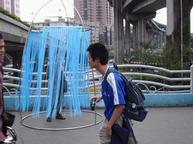 © Klaus Obermayer
© Klaus Obermayer
Empfangshalle (Lobby) researched the behavior of cell phone users. This artistic duo’s actions/performances staged to achieve specific effects and reactions visualize the new spaces and gestures engendered while cell phone users are on the line. There are many examples of how we create mobile “private spheres” for ourselves to communicate in public without disruption: there’s the caller who’s completely withdrawn inside himself, his eyes fixed to the ground as he makes his rounds on an uncharted path; and then there’s the one seated in the bus with his hand cupped over his mouth in a futile attempt to prevent others from overhearing an urgent discussion of his relationship problems.
Having come to the realization that “Whoever uses his cell phone in public disassociates himself from his surroundings via real or virtual spaces,” the artists formulated and constructed prototypes of “mobile telephoning spaces” that will be offered in conjunction with a worldwide telephone service.
Empfangshalle (DE)
12
Jul
When you compare submissions to the 2006 Prix with their counterparts 10 years ago, you can observe a new approach now being taken by younger animation artists. Technological fascination with digital 3D animation and highly complex animation software packages has largely subsided. Experimentation is once again being done using the artist’s own means: analog and digital animation techniques, homebrew programs, and an uncomplicated blend of highly diverse methods and visual vocabularies. Animation is understood as an individualistic form of expression. The prerequisites don’t have so much to do with technical means; rather, this is more a matter of time personally committed. In terms of numbers, degree projects by undergrads, works by individual animators, and studio efforts are represented in approximately equal proportions among the best works. Often, the inquisitiveness of those creating this art is not primarily focused on the result to be achieved but rather on the process of achievement itself. The final products thus constitute animation very much in line with Norman McLaren’s definition of it as “the art of manipulating the invisible interstices that lie between the frames.”
12
Jul
This term could be used to describe a narrative motif that was encountered especially often among 2006 entries and, accordingly, is being featured in its own thematic showcase at this year's Animation Festival. These works present us with a character situated in his own miniature world, a domain that leads a life of its own as an illusionistic machine whose mechanism the protagonist must deal with.
First off, there’s Yu Seock Hyun’s film “The Chamber” that shows us a space inside of which is located another small space in the form of a stop-action animation console. The protagonist is obviously an animator who doesn’t recognize at first that the space in which he’s situated is interrelated in a very curious way with the modeled space.
Another very beautiful work of animation is “Dynamo” (F. Le Nezet, M. Goutte, B. Mousquet), which presents to us a world whose constant rotation is not something that can be taken for granted. In fact, the two inhabitants have their hands full maintaining this state of motion.
And then there’s the protagonist of Robert Depuis’ “Exit” who is unable to carry out his appointed task precisely because he’s unaware of the fact that he’s just a character in an animated film.
What all these entries have in common is their confrontation with the artificiality of cinematic illusion, an approach that not infrequently refers directly to the animation process itself. You’re reminded of a famous figure from the infancy of animation: Max Fleischer’s Koko the Clown. This rotoscope-produced character was dissatisfied with his role as a two-dimensional drawing and, much to the displeasure of his creator, fled into the real world.
12
Jul
At first, it seems rather unusual to categorize animated films according to the number of colors they employ, but an initial perusal of this years submissions made this virtually unavoidable.
A considerable number of films utilized a monochrome, intensely illuminated graphical style that usually has to use only B&W in order to achieve the desired effect. The most prominent example of this is “Sin City,” a film that also inspired many other works of animation.
“Renaissance,” a full-length German-French co-production, impressed connoisseurs of animation with urban visions in the style of Hugh Ferris or Kettelhut’s “Metropolis.” Technically extravagant, the film gets by with a color depth of one bit.
This style is used to great advantage in “The Regulator.” Like its predecessor “Le Processus,” every single frame in this film exhibits outstanding graphical quality that can easily stand up to comparison with illustration work in the best comics. What’s more, Philippe Grammaticopoulos has also succeeded in imparting a magnificent, reduced vocabulary of motion to this work.
Its visual counterpart is the grandiose “Who I am and what I want” (C. Shepherd, D. Shrigley), a seemingly spontaneously conceived autobiography whose tempestuous style comes across as if it had been set down on paper (Flash?) with a black ball-point pen in one uninterrupted session of creativity.
12
Jul
Events, Concerts & Performances | posted by Maria Hieslmayr | at 08:59:00
Maschine Mensch (Machine Man)
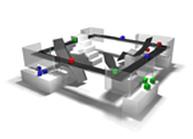 © Christopher Rhomberg / Tobias Zucali
© Christopher Rhomberg / Tobias Zucali
Direct control over a human being is turned over to a completely automatic system. This experimental set-up consists of an abstracted production line on which the component “human being” is deprived of control over his own body via electrical muscle stimulation and turned into an insignificant gear in the larger mechanism. When and how the human’s limbs are moved is determined by the computer. Thus, a person becomes a slave of a system that a person had originally designed—the perversion of the man-machine relationship.
The "Maschine Mensch" project received an Honorary Mention at Ars Electronica 2005 in [the next idea] grant competition.
Christopher Rhomberg (AT)
Tobias Zucali (AT)
5
Jul
Michihito Mizutani is a interaction designer who has been researching the unconscious communication that occurs between people.
Michihito Mizutani: Emotional Communication
5
Jul
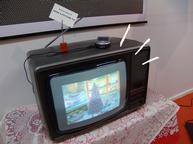 © Michihito Mizutani
© Michihito Mizutani
The Emotional Communication project provides a series of communication tools. They don’t mean to substitute the existing communication tools such as mobile phones. The Emotional Communication tools are subtle and quiet tools. They are useless when you need to give a clear message to others. We can use mobile phones in that case but the Emotional Communication tools will help you feel others who you want to be connected to. They mean to fill the gap of physical and mental distance between friends and family.
The communication tools are called Talking Glass, Sharing the Moment and Narrowcasting TV. Talking Glass is a cup, which enables users to enjoy interaction while they toast their glasses. In Sharing the Moment, a couple with a long distance relationship can share a moment of living together. Finally in Narrowcasting TV, elderly people can receive photos on their TV screens that are taken with a mobile phone by their children or grand children.
Emotional Communication: Michihito Mizutani
4
Jul
Li Xin (CN): BA in graphic design from Central Academy of Fine Arts, Beijing. BA in interactive media design from Designskolen Kolding, Denmark. Currently: MA degree student, Media Lab Helsinki. www.thoughtbird.com
Eirik Fatland (NO): BA in interactive media design from Designskolen Kolding, Denmark. Currently: MA degree student, Media Lab Helsinki. Role-playing artist. www.efatland.com
Li Xin & Eirik Fatland: Credits NeverEnding
4
Jul
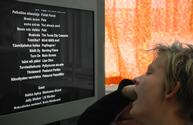 © Li Xin
© Li Xin
"Credits NeverEnding" is an interactive TV program, created for Finnish television channel Dina. Credits NeverEnding is intended for television's off hours, and was developed as part of a project to produce intentionally boring TV – "Boredom is a luxury anyone can afford".
The sight of movie credits on television is usually taken to signify the ending of one program, and the beginning of another. "Credits NeverEnding" subverts this convention by being credits for a movie that never existed, and holding the viewer in suspense for a program that never comes. The credits loop and change, but may scroll over the screen for hours at end.
The names and titles on the list come from the viewers themselves. A viewer with the right mix of attentiveness and time to kill will eventually discover the URL of the website where new credits may be entered. Viewers enjoy nearly total freedom to shape the neverending credits, including promoting themselves. Nothing is true until it is on television.
Credits NeverEnding: Li Xin & Eirik Fatland
3
Jul
Minna Nurminen (FI, born 1973) is a video editor currently working on interactive tv and cinema projects. Sankari in her master's thesis work at The University of Art and Design Helsinki.
Petri Kola (FI, born 1974) is an interactive media director, designer and researcher. Currently he is pursuing his PhD from The University of Art and Design Helsinki. For more information see www.petrikola.org
Minna Nurminen & Petri Kola: Sankari Show - The Ultimate Live Talk Karaoke
3
Jul
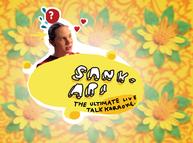 © Minna Nurminen, Petri Kola
© Minna Nurminen, Petri Kola
Sankari ('hero' in Finnish) is a new type of improvisational show. In the Sankari Show members of the audience make up and perform the lines for Elias, the main character, as he tries to navigate his way through everyday life's rough patches. Sankari is both media art and a TV-format. It received an honorable mention at the Transmediale05 digital art festival in Berlin and took the top prize at the 2003 MindTrek event. Currently, Sankari is being developed as a TV-show.
Participants in the Sankari Show compete against each other in the areas of verbal and improvisational ability. The hero of the show is Elias, but he doesn't have a voice – alone he is helpless. Contestants give him a voice and what they say determines his fate. Sankari offers people a fun way to perform in front of an audience. It's karaoke, a TV-drama and a video game.
Sankari was created at UIAH as the final thesis of Minna Nurminen and Petri Kola. From the very beginning, the idea was to create a media piece equally at home on television or as a performance at bars and festivals.
Sankari Show - The Ultimate Live Talk Karaoke: Minna Nurminen & Petri Kola
2
Jul
Campus | posted by Gerda Hinterreiter | at 14:30:00
Miikka Junnila, Andrii Khrupa, Anssi Mutanen, Noora Ojala & Karoliina Talvitie-Lamberg
Miikka Junnila (FI), MSc in computer science, and finishing his MA studies in New Media. Working background in semantic web research and university teaching, nowadays concentrating on innovative game, interaction and concept design.
Anssi Mutanen (FI), has great experience in computer games (since 1984), user centred design and GUI design.
Noora Ojala (FI), artist. Creativity in various fields of arts, and in different visual spaces - both public and private - and questions connected to it such as commercialism, domination and subjectivity. Creative resistance, studies in Fine Arts and New Media.
Karoliina Talvitie-Lamberg (FI), MA in literature and politics, MA in New Media(UIAH), PhD student. Grad. level film studies in UA, USA. Nowadays working as a concept designer, scriptwriter and teacher of new media scriptwriting. Working background copywriter, producer, PR manager.
Miikka Junnila, Andrii Khrupa, Anssi Mutanen, Noora Ojala & Karoliina Talvitie-Lamberg: Molly | Case
2
Jul
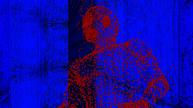 © Molly | Case
© Molly | Case © Molly | Case
© Molly | Case
Molly | Case is an interactive short film inspired by William Gibson's Neuromancer. Two people are longing for a connection with each other in a little hotel room of the future, but the different realities of the world as we know it, cyberspace and the world of dreams don't allow real contact. A mirror acts as a gate between the subjective realities of Case and Molly, and the user can change his/her point of view whenever he/she likes.
ICE, the invisible barrier software in the cyberspace makes sure data remains untouched. Similar psychological barriers keep all levels of reality cold and distant, from the electric, dynamic blues of the cyberspace to the lack of light in reality. This mood is the heart of the film. The mixed reality levels make the story complicated, and understanding the whole tragedy needs multiple viewings. This also emphasizes the need for interaction to open up the different perspectives.
Molly | Case: Miikka Junnila, Andrii Khrupa, Anssi Mutanen, Noora Ojala & Karoliina Talvitie-Lam
1
Jul
Helena Hyvärinen is a Finnish scriptwriter/Director/Producer who is graduating from the University of Art and Design Helsinki/Media Lab. She is mostly focusing on animation, documentary film and interactive media.
Reka Kiraly is a Hungarian born graphic designer living in Finland. She graduated from the University of Fine Arts Budapest in 2003, and finishing her studies at the University of Art and Design Helsinki 2006 spring. Her interest is in Inclusive Design and Illustration.
Cvijeta Miljak (HR) has been actively working in the field of visual communications since1998 (BA in graphic design). Currently attends MA studies in graphic design and new media at UIAH. Interested in experimenting with potential of various media regarding the interpretation of visual narrative structures.
Helena Hyvärinen, Reka Kiraly & Cvijeta Miljak: Päämaja/Headquarters
1
Jul
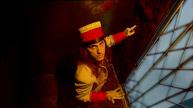 © Cvijeta Miljak
© Cvijeta Miljak
Päämaja/Headquarters is an interactive film on a DVD platform. The story is situated in a surreal world of elevators, and introduces a liftboy being challenged by an almost invisible antagonist – a flea – in a quest for power. An interactive point in the film reveals the possible outcomes of their struggle, and leads to three different conclusions. In general, the film explores aspects of the omnipresent theme of human relationship to power and plays with ideas of hierarchy and self perception.
Päämaja/Headquarters was inspired by ideas from Dostoevsky’s novel Crime and Punishment.
Päämaja/Headquarters: Helena Hyvärinen, Reka Kiraly & Cvijeta Miljak
30
Jun
Campus | posted by Gerda Hinterreiter | at 14:30:00
Janne Kaasalainen, Tanja Bastamow, Miikka Junnila, Miska Natunen & Jürgen Scheible
Tanja Bastamow (FI) is a production designer specialized in digital post
production for film and television, 3D animation and virtual set design.
She is currently launching her own company, Skyrocket Studios.
Miikka Junnila (FI), MSc in computer science, and finishing his MA studies
in New Media. Working background in semantic web research and
university teaching, nowadays concentrating on game, interaction and
concept design.
Janne Kaasalainen (FI) is currently working as a concept designer at Nokia
Research Center and finishing his MA & MSc studies. In the past he has
been working on game concepting and 3d animation on various projects.
Miska Natunen (FI) is an MA student at the Media Lab, University of
Art and Design, Helsinki. Experienced in web, game, sound and music
design, he's currently working as a concept and software designer for
Twinkle Oy, Helsinki.
Jürgen Scheible (Artist: Lenin’s Godson), Germany, a Researcher, Engineer and Media-Artist. He is a PhD candidate at Media Lab, Univ. of Art & Design, Helsinki and was a visiting scientist at MIT, USA. 2006 he became a Forum Nokia Champion, being a bridge builder between art & engineering.
Janne Kaasalainen, Tanja Bastamow, Miikka Junnila, Miska Natunen & Jürgen Scheible: Snowman in Hell
30
Jun
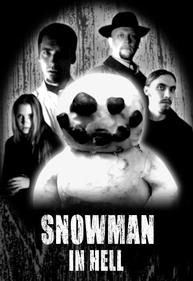 © Bastamow, Junnila, Natunen, Scheible
© Bastamow, Junnila, Natunen, Scheible
Hell is no place for a snowman - but some days are worse than others. You start a desperate journey through the perils of evil and treachery. Listening to the voice of a murdered man inside your head, you begin to realize that your fortune is bound to the souls burning in the eternal flames…
Snowman in Hell is an experimental computer game with hectic action and sophisticated puzzles. It’s also an epic horror story about a snowman with nothing to lose, inspired by Dante's Inferno and film noir.
There is a need for games that make things differently. Even a traditional platform game can feel fresh, if there is something new in the mix: schizophrenic dialogue during the levels, graphics made from garbage and clay, para-realistic simulation of physics, delicately grotesque soundscape… Quoting Pelit, the biggest game magazine in Finland: “Snowman in Hell guarantees an unforgettable experience".
Play it online at http://mlab.uiah.fi/snowman
Snowman in Hell: Janne Kaasalainen, Tanja Bastamow, Miikka Junnila, Miska Natunen, Jürgen Scheible
29
Jun
Koray Tahiroglu (TR)
He is a sound artist, performer and a researcher who grew up in Istanbul. He has been performing noise and electronic music collaborating with different sound artists and performers as well as with solo performances.
Joni Lyytikainen (FI)
He is a sound artist and freelance graphic designer living in Helsinki. His interest in sound has lead the way into electro-acoustic music and searching for new ways for musical creation in sonification of abstract data.
Koray Tahiroglu & Joni Lyytikäinen: SolarDuo Projekt
29
Jun
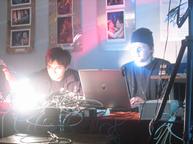 © Piia Hautamäki
© Piia Hautamäki
The project began during a workshop in 2003 at Media Lab Helsinki when Koray Tahiroglu & Joni Lyytikainen tried to connect a solar panel directly to a sound mixer. However, they discovered that more electric components were needed to achieve different sound structures from a solar panel. The artists created circuits that are based on the example by Ralf Schreiber, which inspired them to create their own solar panel instruments.
SolarDuo Project experiments with the possible sound structures that light waves can create. The project utilizes analog sounds together with the algorithms that generate changing set of sonic relations overtime. Analog sounds and computer generated sounds release an unexpected richness of the sound processing in real-time performances. In their performance they also sonify solar data, which is gathered from terrestrial and orbiting solar instruments.
SolarDuo Project performed at Piksel05 Festival Bergen/Norway, Ctrl_Alt_Del Sound Art Festival – the 9th Istanbul Biennial Istanbul/Turkey, Aureobel Launch Event, Art's Birthday 2005 and Art's Birthday 2004 in Helsinki/Finland.
SolarDuo Project: Koray Tahiroglu & Joni Lyytikäinen
Blog Authors:
Maria Hieslmayr Cornelia Sulzbacher Wolfgang Bednarzek Gerda Hinterreiter Didi Offenhuber Beta Lounge Artists David Cuartielles Sonja Meller StWSt denCity.net
Search:
Categories:
Conferences Animation Festival Events, Concerts & Performances Campus Exhibitions e-lobby Prix Ars Electronica
Recent Posts:
Photographs of the 2006 Festival Media lab thanks! Ars Electronica Center FM4 Live from Ars Electronica in Linz
Archives:
Posts 180 - 160 Posts 160 - 140 Posts 140 - 120 Posts 120 - 100 Posts 100 - 80 Posts 80 - 60 Posts 60 - 40 Posts 40 - 20 Posts 20 - 0


